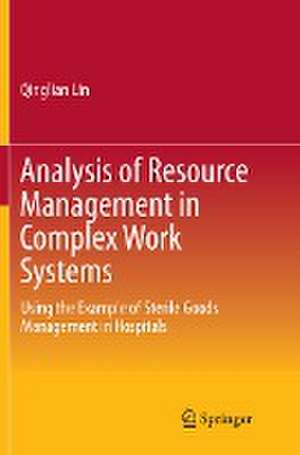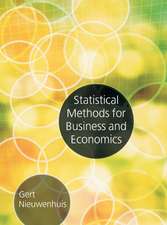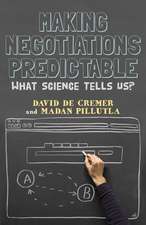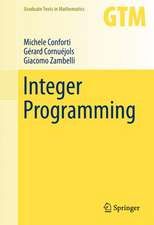Analysis of Resource Management in Complex Work Systems: Using the Example of Sterile Goods Management in Hospitals
Autor Qinglian Linen Limba Engleză Paperback – 22 apr 2018
| Toate formatele și edițiile | Preț | Express |
|---|---|---|
| Paperback (1) | 632.37 lei 43-57 zile | |
| Springer Nature Singapore – 22 apr 2018 | 632.37 lei 43-57 zile | |
| Hardback (1) | 638.43 lei 43-57 zile | |
| Springer Nature Singapore – 29 aug 2016 | 638.43 lei 43-57 zile |
Preț: 632.37 lei
Preț vechi: 743.97 lei
-15% Nou
Puncte Express: 949
Preț estimativ în valută:
121.02€ • 125.88$ • 99.91£
121.02€ • 125.88$ • 99.91£
Carte tipărită la comandă
Livrare economică 14-28 aprilie
Preluare comenzi: 021 569.72.76
Specificații
ISBN-13: 9789811095481
ISBN-10: 9811095485
Ilustrații: VII, 123 p. 58 illus., 57 illus. in color.
Dimensiuni: 155 x 235 mm
Greutate: 0.2 kg
Ediția:Softcover reprint of the original 1st ed. 2017
Editura: Springer Nature Singapore
Colecția Springer
Locul publicării:Singapore, Singapore
ISBN-10: 9811095485
Ilustrații: VII, 123 p. 58 illus., 57 illus. in color.
Dimensiuni: 155 x 235 mm
Greutate: 0.2 kg
Ediția:Softcover reprint of the original 1st ed. 2017
Editura: Springer Nature Singapore
Colecția Springer
Locul publicării:Singapore, Singapore
Cuprins
1 Introduction.- 1.1 Complexity of Health Care Systems.- 1.2 Changes in Health Care Systems.- 1.3 Challenges for Hospital Management.- 2 Research Problem.- 3 Aims.- 4 Methodical Approach.- 4.1 Foundation of the Methodology.- 4.2 Structure of the Thesis.- 5 Results of the Development of DERESIS Model.- 5.1 Situation of Resource Management using the Example of Sterile Goods Management in Hospitals.- 5.2 Knowledge Requirements of DERESIS Model.- 5.3 Development of the Theoretical DERESIS Model.- 5.4 Evaluation of the DERESIS Model.- 6 Discussion.- 6.1 Discussion of the Methodology for the Development of the DERESIS Model.- 6.2 Discussion of the Results.- 6.3 Strengths and Weaknesses of this Study.- 6.4 Transferability.- 7 Future Research.- Acknowledgment.- Reference.- Glossary.- Appendix.- Appendix 1: Overview of Medical Decision Making.- Appendix 2: The 6-layer Model.- Appendix 3: The Layout of CSSD.- Appendix 4: The General Flow of Sterile Goods between Operating Theatre and Central Sterile Supply Department.- Appendix 5: Five Scale Fuzzy Linguistic of Performance Values in Hospital of In-house and Outsourcing Sterile Goods.- Appendix 6: Five Scale Fuzzy Linguistic of Weight of Importance of Each Criterion.- Appendix 7: Five Scale Fuzzy Number of Performance Values in Hospital of In-house and Outsourcing Sterile Goods.- Appendix 8: Five Scale Fuzzy Number of Weight of Importance of Each Criterion.- Appendix 9: Symbol.
Notă biografică
Qinglian Lin is an assistant professor at the School of Management, Xiamen University. She received her Ph.D. degree from the Technical University of Berlin, Germany. Her research interests include decision-making in complex work systems, healthcare management, artificial intelligence, multidisciplinary contexts, etc.
Textul de pe ultima copertă
This book develops and assesses a decision-making model for resource management in complex work systems in line with the “Systems Engineering” method. It applies the Balanced Scorecard to the development of the criteria system for decision-making, and employs fuzzy linguistics theory to evaluate the alternatives. Further, the book assesses the application of this model in a hospital that has to decide whether or not to outsource its sterile goods. The use of the model opens up a diverse range of fields for decision-making in the area of complex work systems.
Caracteristici
Presents resource management in the context of complex work systems Opens up a diverse range of fields for decision-making Provides a scientific model to improve the efficiency and effectiveness of resource provision Includes supplementary material: sn.pub/extras











